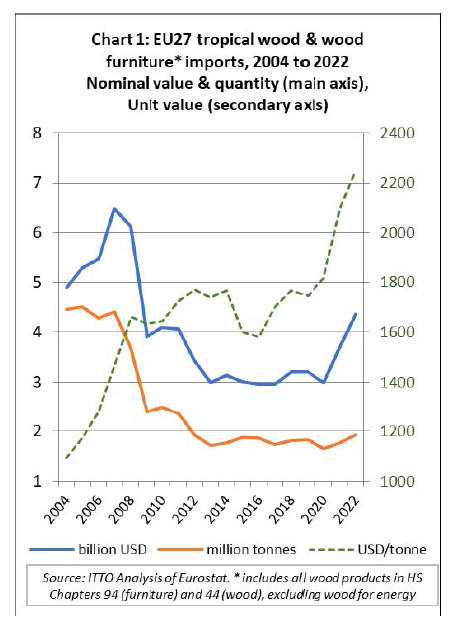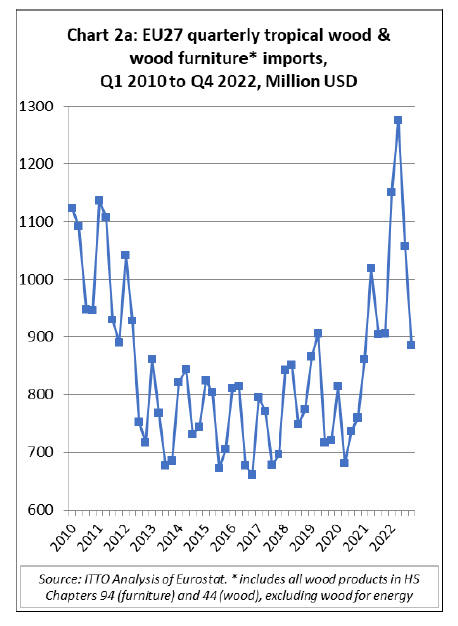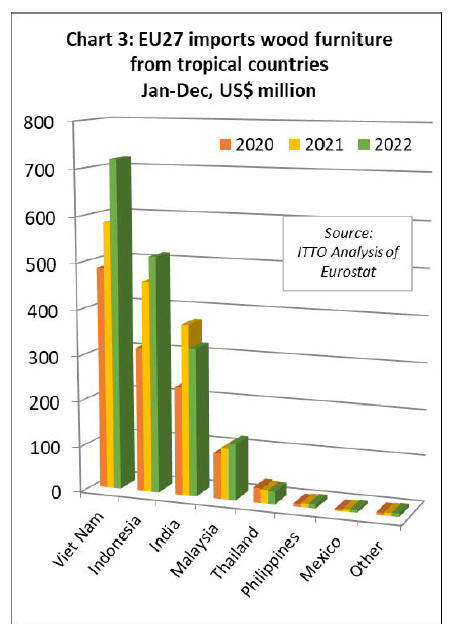|
Report from
the UK
Price increases drive up EU27 tropical wood imports
In 2022 the EU27 imported 1.94 million tonnes of tropical
wood and wooden furniture products with a total value of
US$4.37 bil. respectively 10% and 18% more than the
previous year. Compared to the pre-pandemic level of
imports in 2019, imports last year increased 36% in value
terms but only 6% in quantity terms.
Chart 1 shows EU27 trade trends for the period 2004 to
2022 puts last year's trade figures into long term
perspective. The only other increase in tropical wood
import value comparable to the 2021-2022 period occurred
in 2006-2007 when abundant liquidity and a real estate
boom created a bubble economy immediately preceding
the financial crash of 2008-2009.
However, unlike in 2006-2007, the actual quantity of
EU27 imports of tropical wood and wooden furniture
products last year was only marginally above the long
term average which has remained broadly stable at around
1.8 million tonnes for the last decade.
The increase in value of EU27 imports of tropical wood
and wooden furniture products in the last two years was
driven by the sharp increase in prices. The average price
per tonne of all EU27 tropical wood and wooden furniture
imports increased progressively from US$2,800 in 2020 to
US$2,100 in 2021 and US$2,250 in 2022.
This occurred initially as severe supply shortages and a big
rise in freight rates coincided with the short-term surge in
demand due to higher refurbishment activity during
COVID lockdowns.
The surge in demand for tropical products in the EU was
further boosted in 2022 by COVID-recovery stimulus
measures and the war in Ukraine which put pressure on
supplies of alternative temperate wood products.

EU27 tropical wood imports slow as economic outlook
deteriorates
The rise in freight rates and supply shortages only began
to ease in the second half of 2022 as economic conditions
deteriorated and demand for wood products slowed
dramatically.
The war in Ukraine contributed to huge increases in
energy prices in the EU in the second half of 2022, while
business and consumer confidence was hit by expectations
of higher interest rates to control inflation.

In value terms, EU27 tropical wood and wooden furniture
imports of US$1.94 bil. in the second half of 2022 were
20% less than US$2.42 bil. in the first half of the year.
However, import value was still high in the second half of
2022 relative to figures typical in the previous ten years
(Chart 2a).
In quantity terms, total EU27 imports of tropical wood and
wooden furniture of 414,000 tonnes in the fourth quarter
last year were 18% down compared to the previous quarter
and well below the quarterly average of around 450,000
tonnes in the last decade (Chart 2b).

EU economy faces challenges but should narrowly
avoid recession
The challenges now facing the EU27 economy are
identified in EU’s winter 2023 Economic Forecast
published on 13 February which notes that “Core inflation
increased further in January. Consumers and businesses
continue to face high energy costs and … inflationary
pressures are still broadening. Monetary tightening is
therefore set to continue, exerting a drag on investment.
Weakness in consumption is set to persist in the near term
as inflation keeps outpacing nominal wage growth.
Finally, the external environment is expected to continue
providing little support to the EU economy”.
Nevertheless, the 2023 Winter Forecast identifies some
positive developments in the EU economy since the
previous 2022 Autumn Forecast. The new Forecast notes
that “the European gas benchmark price has fallen below
its pre-war level, helped by a sharp fall in gas consumption
and continued diversification of supply sources”.
Furthermore, “the resilience of households and
corporations has been impressive”.
For these reasons, the slowdown in the EU economy in the
second half of 2022 turned out milder than previously
estimated by the EU despite the energy shock and ensuing
record high inflation. In the fourth quarter, the EU
economy managed a broad stagnation, instead of the 0.5%
contraction expected in the Autumn Forecast.
The peak rate of inflation increase may already have
passed and economic sentiment is slowly improving. This
suggests, according to the EU Winter Forecast, that
“economic activity will avoid a contraction also in the first
quarter of 2023” and “the EU economy is thus set to
narrowly escape the recession that was pencilled in back in
autumn”.
Rise in EU27 import value of tropical furniture masks
fall in quantity
In 2022, EU27 import value of wooden furniture from
tropical countries was US$1.73B, 10% higher than the
previous year. This increase in dollar value was entirely
due to higher freight rates and prices and the weakness of
the euro last year. In tonnage terms, imports declined 8%
to 349,400 tonnes during the year.
In 2022 there were large increases in EU27 wooden
furniture import value from Vietnam (+23% to US$720
mil.), Indonesia (+12% to US$515M), Malaysia (+9% to
US$123 mil.) and the Philippines (+10% to US$10 mil.).
Import value fell from India (-13% to US$324 mil) and
Thailand (-7% to US$28 mil.). EU27 wooden furniture
imports from all other tropical countries were negligible
last year (Chart 3).

EU27 imports of tropical sawnwood up 18% in 2022
After two slow years during the global pandemic, EU27
imports of tropical sawnwood recovered ground last year.
Imports of 1,014,000 cubic metres last year were 18%
higher than in 2021 and 30% more than in 2020. EU27
import value of tropical sawnwood increased 22% to
US$904 mil. in 2022.
Sawnwood imports increased last year from all the largest
tropical suppliers to the EU27 including Cameroon (+16%
to 360,700 cubic metres), Brazil (+42% to 166,200 cubic
metres), Gabon (+19% to 164,500 cubic metres), Malaysia
(+8% to 85,800 cubic metres), Congo (+12% to 75,800
cubic metres) and Ghana (+18% to 30,100 cubic metres).
Of smaller tropical sawnwood supply countries, there were
large percentage increases in EU27 imports from DRC
(+114% to 15,000 cubic metres), Suriname (+66% to
10,800 cubic metres), Indonesia (+39% to 10,600 cubic
metres), CAR (+150% to 6,800 cubic metres), and Angola
(+8% to 6,700 cubic metres). In contrast imports from
Côte d'Ivoire fell 29% to 19,400 cubic metres and from
Ecuador were down 14% to 18,700 cubic metres. (Chart
4).

Unlike sawnwood, EU27 imports of tropical
mouldings/decking were slow last year. Imports of
172,900 tonnes in 2022 were 5% less than the previous
year. The trend in value terms was more positive, rising
21% to US$396 mil. last year indicating a sharp rise in
import prices.
Supply shortages and concerns about future demand
contributed to a fall in the quantity of mouldings imports
from Indonesia, which declined 20% to 52,600 tonnes last
year.
The fall in imports from Indonesia was partially offset by
a 54% increase in imports from Gabon to 14,600 tonnes.
Imports from Brazil, the largest supplier in recent years,
were stable at 66,400 tonnes last year.
Of smaller suppliers, there were increases in imports from
Bolivia (+30% to 8,000 tonnes) and Malaysia (+19% to
7,400 tonnes). Imports from Peru declined by 14% to
12,300 tonnes in 2022 after strongly rising the previous
year (Chart 5).

The EU27 imported 119,400 cubic metres of tropical logs
with value of US$65 mil. in 2022, respectively 11% and
10% more than the previous year. EU27 log imports
increased from all three of the largest African supply
countries last year; Congo (+4% to 48,600 cubic metres),
CAR (+28% to 25,000 cubic metres), and DRC (+21% to
13,200 cubic metres). Imports from Liberia also increased
4% to 6,300 cubic metres last year.
However, log imports were down 26% to 11,000 cubic
metres from Cameroon. Log imports increased sharply last
year from negligible levels the previous year from two
South American countries, Paraguay (+50% to 3,700 cubic
metres) and Guyana (+148% to 2,800 cubic metres).
(Chart 6).

Large gains tropical hardwood veneer from Africa
The EU27 imported 350,000 cubic metres of tropical
veneer with value of US$234 mil. in 2022, respectively
14% and 13% more than the previous year. Imports of
tropical veneer from Gabon, by far the largest supplier to
the EU27, increased 5% to 172,400 cubic metres in 2022.

EU27 tropical plywood imports of 296,800 cubic metres
with value of US$254 mil. in 2022 were respectively 32%
and 52% more than the previous year.
Demand for tropical plywood was boosted in the EU last
year due to sanctions on trade with Russia leading to
shortfalls in supply of birch plywood which in certain
applications is a direct competitor to tropical products.
EU27 imports of tropical plywood from Indonesia, the
largest supplier, increased 13% to 92,500 cubic metres last
year. However, the biggest percentage increase was in
imports from Gabon which increased 124% to 72,000
cubic metres.
Imports of tropical plywood also increased sharply from
Vietnam (+92% to 24,500 cubic metres), Morocco (+47%
to 21,700 cubic metres), Brazil (+94% to 14,100 cubic
metres), India (+18% to 10,200 cubic metres), and the UK
(+17% to 8,300 cubic metres).
Tropical plywood imports from Paraguay increased from
negligible levels in 2021 to 4,500 cubic metres last year.
These gains offset a 32% decline in imports of tropical
hardwood faced plywood from China to 31,000 cubic
metres (Chart 8).

Rise in imports of tropical flooring from Malaysia
continues
The EU27 imported 28,600 tonnes of tropical wood
flooring with value of US$89 mil. in 2022, respectively
37% and 45% more than in the previous year. The rise in
EU27 wood flooring imports from Malaysia, that began in
2020, continued last year.
Imports of 13,800 tonnes from Malaysia in 2022 were
50% more than in 2021. There were also large gains, from
a smaller base, from Indonesia (+34% to 7,100 tonnes) and
Brazil (+42% to 2,400 tonnes). Flooring imports from
Vietnam of 3,200 tonnes in 2022 were just 4% more than
in the previous year (Chart 9).

The dollar value of EU27 imports of other joinery
products from tropical countries, which mainly comprise
laminated window scantlings, kitchen tops and wood
doors, increased 27% to US$286 mil. in 2022.
Unlike for furniture, the rise in import value for joinery
last year was not driven entirely by rising prices but was
also indicative of an increase in import quantity. In
quantity terms, the EU27 imported 106,600 tonnes of
tropical joinery products in 2022, 20% more than in the
previous year.
Import value from Indonesia, the largest tropical supplier
of this commodity group to the EU, was stable at US$121
mil. million in 2022. However import value increased by
49% to US$91 mil. from Malaysia, and by 30% to US$27
mil. from Vietnam.
The apparent large increase in imports of this commodity
group last year from China, Norway, and the UK, from
negligible levels to US$12 mil., US$6 mil., and US$4 mil.
respectively is due to a change in product codes from the
start of 2022 allowing more joinery products manufactured
using tropical hardwood in non-tropical countries to be
separately identified (Chart 10).

|